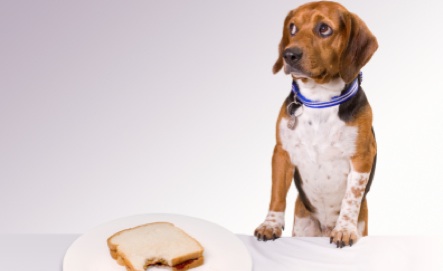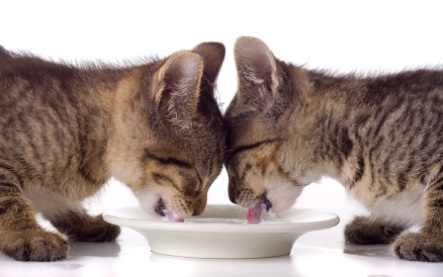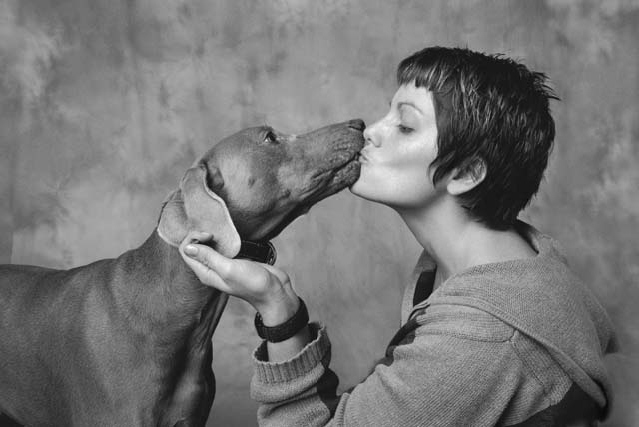
Nonverbal communication is a gift that all living beings share, one you will need to reawaken to better interact with and care for your animal companions. Most dog and cat lovers already understand canine and feline body language, which is one non-verbal technique. But you can use your other, natural, nonverbal communication skills, and actually begin to see things through your dog or cat’s eyes, and become his/her voice.
You can learn animal communication by taking a class or reading some of the great books available today on the subject. But many of the basics are so simple that we can easily begin nonverbally communicating right away. Remember that, long before humans had spoken language, we were able to communicate among ourselves and with the animals; it is a kind of heart to heart communication skill that we all possess.
Did you ever know a set of twins who said they each knew what the other was thinking, or you heard your mother say she had “woman’s intuition” or “just knew something was wrong.” Have you ever had an image of a friend come to mind and then received a phone call from that very person saying,“I was just thinking about you and wanted to say hello”? These are all examples of nonverbal communication.
Those of us fortunate enough to have been raised with animal companions probably “talked” to them all the time — and they “talked” back — without words. You do not have to be Dr. Doolittle to do it, either. You may have chalked up your own memories of such experiences to an overly active imagination. But it is far more likely that, as a child, you were still unencumbered by belief systems that would tell you otherwise.
You can try it anytime with your own dog or cat, simply by listening to your heart, instead of to your head with its endless, meaningless chatter. Just let those thoughts pass by you, and relax and breathe deeply. You are going to visualize your furry companion coming over to you. Close your eyes so that you focus on every detail: the feeling of your dog or cats lovely coat, those deep, trusting eyes staring up at you, and imagine him walking toward you. Often, even the first time you try it, your cat or dog will be by your side before you know it, so happy that you’ve communicated with him at long last, in his own way.
Please do not worry about whether you are “doing it right.” Not every person (or animal) is visually oriented. Visualization is just like imagining or remembering. It may come as actual pictures, like a movie, or as sounds, or a voice, or as feelings, or just a sense of “knowing.” Any way you receive the information is valid.
It is very important to always communicate in positive terms — “see” what you want your dog or cat to do, rather than focusing on unwanted behaviours. Dogs and cats live fully in the moment, so picture them as you want them to be.
For instance, do not ask them if they want to go to the vet or the groomer or for a ride in the car. Why? Because, they do not know how they will feel until they get there to that exact moment in time. Unlike us, dogs and cats live in the moment. What lessons we can learn about being here — right now! So visualize them peacefully riding in the car, or calmly allowing the vet to examine them.
Practice visualizing positive, loving pictures rather than negative, worrying ones. Have you noticed that the things you worry about often seem to happen? Practice positivity, and positive visualization, and you will find it spilling over into every aspect of your life.
This is so crucial when communicating with your animal companions. If you say, for example (either out loud or nonverbally), “Don’t jump on the couch,” your dog or cat sees an image in your mind’s eye of him jumping on the couch. He won’t get the “don’t” part of it. He’ll think oh, she wants me to jump on the couch. Your yelling at him to not jump on the couch is then a mixed signal. Instead, say and visualize what you DO want him to do. In this case, you would say, in an even but stern tone, “Go to your bed!” Then gently carry or lead him to his bed to reinforce the positive behaviour.
It is impossible to hide your feelings from dogs and cats. They always know — and they may “get it” even before we know ourselves. They can even take on your stresses, fears, and frustrations. Over time, these may manifest as illness. So it is a good idea to even refrain from arguing in front of your animal companions; it is extremely stressful for them. It is not fair to treat them as if they are not in the room when we lose control of our emotions. Their sensibilities should be respected.
To give you an idea how sensitive dogs are, Rupert Sheldrake, a British biologist and the author of Dogs That Know When Their Owners are Coming Home, did an experiment in which he placed video cameras with time codes in the house, aimed to catch the action of the homebound dog. At a random time, unbeknownst to the human or dog, the human would get a phone call on a cell phone from a distance away, saying to return home. At that very instant, cameras showed that the homebound dog would become excited and run to the door to wait for their human. This experiment was repeated hundreds of times, and were all confirmed by the videos. The moral of this story: do not feel silly practising nonverbal communication, EVER!
You can also practice this pure heart-to-heart communication skill with a new animal companion, or with animals at dog or cat shows or even shelters. First, learn the cat or dog’s name, if possible. Try saying the name in a sweet, soft, “feminine” (high-pitched) voice. We pretty much all do that with animals and babies, unknowingly that is. It seems, in the animal world the female voice is the most nonthreatening. If you are a man, or a woman with a deep voice, raise your pitch and speak softly.
Of course, always ask the guardian if it is okay to work with and touch the animal; and then ask the animal’s permission.
To start, if you can, get down a bit lower than normal (ideally, at the animal’s eye level) and imagine the dog or cat sitting on the floor of your own home. You may get a response as a picture of what his own home looks like from his point of view. Perhaps you can distinguish the outlines of a bed or the legs of a coffee table from underneath: what the dog sees from that perspective. Your image may look like a black-and-white negative, reverse image, rather than a normal photo type memory.
If you do not get a picture, it does not mean you are not doing it right. The dog may just be telling you he is not allowed in that room. Trust yourself and the feelings that come up and continue to listen with your heart. Accept the images or feelings you do get, and go on. He may tell you something about what he likes or dislikes. Or he may be content exactly where he is right now. Keep going anyway, and just let him talk through his own senses.
What are you getting? Is he showing you what his floors look or feel like? Do cold, slippery floors make him nervous because he skids on them? Now visualize the cat or dog’s feeding area. What kind of food does he eat? Do you taste or feel any textures in your mouth? What about water? Is it fresh and clean? What has he smelled recently? He may change the picture you send to reflect his truth, and he may present it to all of your senses or just some of them.
As you continue, do see other animals where he lives? Send him a picture of one of your animal companions. What does he say to that? What does he like to play with? Cats may have little balls and catnip toys, and dogs may have chew toys, tennis balls, or maybe even a Frisbee. Give him these images and see what you get back. If his human companion is there, ask questions to help you assess your images. After you present an image to him, remember to leave a space for him to answer.
As you read the impressions your animal friend is sending. You may receive feelings of space and expansion if he has room to play and places to rest in — or feelings of contraction if he has been caged or otherwise too restricted.
Perhaps you may feel he is trying to tell you about an aggressive person. This person may not necessarily be a man; it could be a woman or child with a strong personality — dogs and cats sense human beings as personalities, not as men and women. Ask the dog or cat non verbally how he likes this person. He may wish the person would leave him alone, or he may enjoy playing with the person but cannot understand why he gets scolded for playing too roughly.
You can use your nonverbal skills to assess the animal’s well-being through a mental body scan. Just look at the animal, starting with the head and working down the back to the tip of the tail. How do you feel compared with how you felt before scanning? If you feel anything unusual as you continue your scan, you may be on to something. Ask the dog or cat, using his name, how he feels as you move along his body with your eyes.
If you do not have permission to touch the animal, you can pet the cat or dog’s aura. This is more subtle, but just as effective. Think how you’d feel if a perfect stranger just started stroking you without your consent. Then when you use this indirect way of laying on hands by petting the space around the body (which is referred to as the etheric double), you can often feel the animal’s energy and determine whether he is receptive to your touch, which after all will leave your scent on this dog or cat. By using the etheric double area you will find that this in itself is a valuable avenue of communication and diagnosis, and through it you can offer much healing, especially when you use love as the catalyst.
As you practise, your skills will improve. When doing a mental body scan, you may feel discomfort in certain parts of your own body. While this is important information, you do not need to hold it in your body. Simply release the feeling and say to yourself,“This animal’s feelings are his own. I release them.” In your mind’s eye, wrap the dog or cat in healing white light, or say your blessing. Then “turn off” the discomfort, much as you would the TV when it transmits images you do not like. As simply as you would change the channel; just change the subject. It is never necessary to be the recipient of any other being’s pain.
Nonverbal communication seems to come most easily with other people’s animals. It is sometimes difficult to practise with our own furry friends because we are so emotionally involved with them. Gradually you will develop a proficiency that you can then apply at home. Most folks do their best communicating with their own animal companions through play. Through play we express and hear verbal, non-verbal, body language, and other communications.
Be sure to talk to your animal companions about their day. Sometimes if you have more than one then they compete to communicate with us all at once. Just give them the time and the space to get it all off their chests. Remember that, they knew you were coming home long before you got there as Sheldrake proved, and have been happily waiting to talk to you!
Nonverbal communication can greatly expand your relationship with animals, but some dogs and cats are reserved, just like certain people are. They simply do not want to converse. Do not be discouraged. And some people never get pictures, only feelings; and that is fine.
Trust yourself, and proceed with openness, imagination and confidence. You are on your way to being a nonverbal communications expert and experience for yourself the intelligence and spirit in all life!
Adapted from an article by Celeste Yarnall









